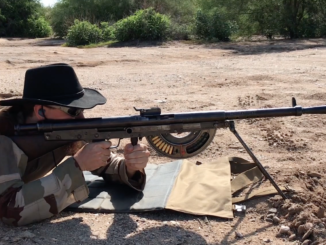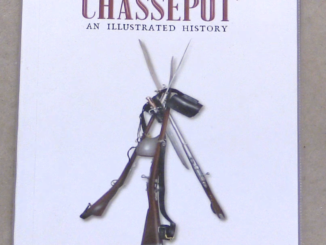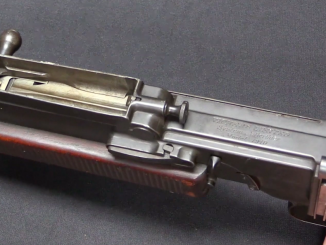When France was developing it’s new suite of small arms in the late 1940s, there was a debate over whether to adopt an intermediate-power cartridge or retain the full-power 7.5x54mm round for the infantry rifle. Initially, a French 7.65x35mm cartridge was developed and used for several years of development (the US .30 Carbine round was also used). During this time, the MAS arsenal submitted prototypes for both submachine gun and assault rifle (“carabine mitrailleuse” – machine carbine) trials. Their model 1949 system was lever-delayed blowback, and virtually the exact same design was used for both types of firearms. A number of different models were made, including folding wood stocks, collapsing wire stocks, and various fire control setups and barrel lengths. Today, we are looking at two of the MAS 49 Carabine Mitrailleuse prototypes, one long barreled with a progressive trigger and folding wood stock, and one shorter with a wire stock and full-auto-only trigger.
Ultimately, the French Army decided to keep the full-power cartridge, and adopted a different MAS-49; the 7.5x54mm semiautomatic rifle that is well known today (and was later improved to the MAS-49/56 pattern). The submachine gun selected was the MAT-49, a simple blowback design. The whole development program for lever-delayed systems at MAS was abandoned, although it would come back twenty years later with the FAMAS.
Many thanks to the IRCGN (Institut de Recherche Criminelle de la Gendarmerie Nationale) for allowing me access to film these prototypes for you!




Simple question. How is the mag reloaded? It appears to have a permanently attached folding mag. I didn’t see any stripper clip guides. Did I miss something?
An OOOPs on Ian’s part. To me, it looks like there is a tab that extends from the folding part that holds a separate magazine in place. But I could be wrong.
Does not seem like a bad design. Looks easy to manufacture and handy to use. Too bad the project got scrapped.
What was mass of this weapon and how it does compare to M2 Carbine (which I presume could be cheaply furnished to NATO primal dozen)?
Which bureaucratic genius decided to circle the serial numbers of these rare guns with what looks like nail varnish?
What you see here is an artifact of the utter lack of common sense applied to small arms design.
We all know that the weapons are going to have to be dealt with administratively; they’re going to be in an arms room or weapons rack for the vast majority of their working lives. Yet… Does anyone design accordingly? Nope.
Put yourself in the position of that armorer who is responsible for the collection Ian is looking at. He’s got a huge variety of different weapons he has to account for, with periodic serial number inventories. Care to imagine how long those inventories take, when you have to get disinterested third parties to come in and do them, and they don’t know where to find the serial numbers on all those different weapons?
Yeah. I can see exactly why whoever it was put that red fingernail polish on those weapons, no matter how much “authenticity” is lost by doing so. At some point, the sheer cost in man hours for administrivia is going to lead to them scrapping those collections, so which would you prefer…?
The M16 series is a perfect example of someone not designing for admin issues. On the old-school M1 and M14, the serial numbers are right there at the top of the receiver, easily findable for every inventory in every rack. You don’t even have to unlock the racks; just look at the receiver tang, and there you are. The M16? LOL… The idiots put the serial number on the lower receiver slabside, so in order to check the serial number, you have to unlock the rack, remove the weapon, and then read the serial number. Any idea how many more man hours that takes, compared to the M14? It ain’t trivial; the pain in the ass you have trying to get these things organized and keep them organized is a major drag on operations and maintenance. If it were easier to do, your armorers could spend more time keeping things fixed and maintained.
I’ve yet to see any individual infantry weapons system designed with the mandatory admin stuff carefully thought through and integrated in such a way as to make life for the armorer and the unit easy and efficient. Little things, like why the hell aren’t the racks usable as transit cases? Why aren’t the cases designed so that they could recharge batteries on sights when the weapons are racked? Why the hell do you have to go through every single rack and take out every weapon to read the serial numbers? Why aren’t the racks/cases designed so as to be sealed against dust and moisture for shipping and storage?
The whole thing is just incredibly stupid, across the board. Nobody ever looks at this stuff, because they’re not the poor schmucks stuck with making it work. If it had been me? Given input on the M16? One damn thing that would have changed would have been to put the serial number on a flat just behind the charging handle, so you could read the sumbitch while it was racked… The number of man hours that little change would have saved over the decades of service the M16 has seen and will see…? Undoubtedly in the millions.
Huzzah! Spoken like the man who has held the inventory clipboard in his hand! All comments are 100% valid. Take hope. I worked in military flight T&E for many, many years. All the factors you discussed are presently being examined as a part of any program’s specifications. Packaging, shipping, inventory, etc. are now all part of any program’s spec, whether it is a new aircraft or a toolbox. All of those issues are now being, “designed in” right from the get go.
However, EVERYTHING in engineering is a trade off. While long term storage and inventory of any item can become very expensive in time effort and money over the course of many years, that cost is written off as part of the overall system’s operational cost. Most people never see and cannot understand those costs. So except for guys like you and I, those costs are ignored. Conversely, designing in and testing all of the packaging, shipping, inventory, storage and other logistics costs up front impacts the initial purchase price of a weapon system. Most people can see and THINK they understand that cost. So that results in people asking the historically famous question, “Why does the Army pay $6,000 for a hammer?” It all comes down to pay now or pay later.
I would love to buy you a beer and discuss this stuff.
“(…)M16(…)”
Keep calm this is only stopgap measure whilst waiting for OICW.
It’s France, so it is actually a much hotter story, involving the nail varnish of the bureaucratic genius’ lover.
“(…)7.65x35mm cartridge(…)”
Dimensions https://municion.org/producto/765-x-35-french-xpl-lrba-satory/
Ballistic comparison against 7,62×33 and Kurzpatrone https://www.thefirearmblog.com/blog/2016/10/28/modern-historical-personal-defense-weapon-calibers-003-7-65x35mm-mas-300-blackout-1940s/
What if the Fre4nch had taken a cue from the Russians and Germans and developed a new cartridge? something like 7.5x40mm, 125-135 grain bullet at around 2350-2450 feet per second? would that have changed the whole game for other European nations?
In reality the other NATO nations would have ended up with what the Americans wanted, 7.62mm NATO. The French have always liked to be different.
The French copies no one and no one copies the French.
France developed the 7.5x54mm service cartridge in, get this, *1929.* The USA started development of the 7.62x51mm, intent on foisting it on Nato and sidelining Belgian interest/experimentation with ze German 7.92x33mm kurzpatrone and the UK development of the 7x43mm/.280 cartridge for the EM-2, “No.9 rifle” and the “Taden” LMG…
After WWII, French industry had rebuilt a service cartridge reserve stockpile of 7.5x54mm cartridges for the future service rifle, and for the automatic rifle, and for the GPMG that awaited adoption [the much-maligned AA-52. So France was not going to adopt the 7.62x51mm. Why the USA didn’t just adopt 7.5x54mm instead of re-designing the the 1889 7.65x53mm Belgian/Argentine Mauser cartridge and calling it something “new” is the real question, to my mind. But, because ‘Murica, we basically redesigned a cartridge ze Germans had developed in the late 19th Century [Oh, and the two won’t interchange, but take a look at the cartridges some time… Too funny!], only to then, post-foisting, adopt SCHV assault rifle cartridges in the form of the 5.56x45mm. A small masterpiece, really. It is the Americans, actually, who have always insisted on being “different”: Football? Metric system? a basic unit of currency that comes in a simple “coin” versus a green-back… One can enumerate the differences ad infinitum and ad nauseam.
Im going to go out on a limb and bet those famous Mauser engineers had something to do with these design wise before moving on to Spain.
At this time, Vorgrimler & cie. were at Mulhouse working on the competing CEAM Mle 1950, where the famous roller-delayed action is already in evidence. I think the similar form factors may just be a product of convergent evolution; working towards a common set of requirements resulting in superficially similar weapons.
Chapeau for taking the time to get Vorgrimler’s name correct.
I check every time— the heart wants it to be a double ‘m’ for some reason. Measure twice, cut once.
Or maybe “chapeau bas”?
By the way: from where originates the French’s post-WW2 obsesion with the lever-delayed blowback action?
The first patent about the lever-delayed action what I have found is John D. Pedersen’s: Firearm, U.S. Patent 1,410,270; application filed: 13th December, 1919.
https://patents.google.com/patent/US1410270
(It is pretty similar in the outlines and the layout to the Remington M51 & M53, but these two are hesitation delayed blowback. – Is it known why this concept is abandoned?)
I was told by a former Heereswaffenamt official (Otto Morawietz) that, when they examined French establishments, it was found that lever-delay had been experimented with already long before 1940. The French interest in this approach is not post-WW2.
“(…)first patent about the lever-delayed(…)December, 1919.(…)”
https://modernfirearms.net/en/library-2/delayed-blowback/ claims that
(Pál Király) eventually produced one of the more popular implementations of delayed (retarded) blowback systems, utilising a two part bolt with retarding lever. His system was originally patented as early as 1910 but only practically implemented in production weapons in 1939…
It is unclear for me in which country he secured said patent.
I am assuming these prototypes also used the Kiraly type of lever delay.
US1073908 Paul Kiraly’s lever delayed patent
https://patentimages.storage.googleapis.com/d4/ab/1a/9b64f9f773bac8/US1073908.pdf
Thank you.
“It is unclear for me in which country he secured said patent.”
Surprisingly I could not found it on the SzTNH.hu (~Hungarian Patent Office). Surprisingly, because I could found Király Pál’s another patent from 1910, which is a simple blowback pistol:
Király Pál & Lovász János: “Önműködő kézi lőfegyver rugózott el nem reteszelt závárzattal” [literally: “Automatic handgun with spring-loaded non-locking bolt action”], patent no.: 59550, date of application: 24th November, 1910.
It is a shame that the SzTNH.hu is only in Hungarian, and there is no possibility to link a patent document.
I found this Austrian patent from 1915:
Király Pál & Lovász János: Trägheitsverschluß für selbsttätige Handfeuerwaffen, patent no.: 69187, date of application: 28th April, 1913.
https://worldwide.espacenet.com/patent/search?q=pn%3DAT69187B
I also found a British patent from 1913:
Paul de Kiraly & Joseph Lovasz: Improvements in Breech-blocks for Automatic Fire-Arms, patent no.: 26783, date of application: 21st November, 1912.
https://worldwide.espacenet.com/patent/search?q=pn%3DGB191226783A
Yes, these have the exactly the same drawing as the mentioned US1073908 patent.
…and no: despite of the first page of the original Austrian patent, the drawing of the 59550 Hungarian patent are totally different.
Thanks for your interest…
According to unclear records… Kiraly first made a prototype in 1906 at Hungary when he was a teacher in University…
What interesting on this subject is… The very close similarity between Kiraly’s and Maxim Silverman’s patent drawings about lever usage which Maxim’s intention seemed to use a weaker main spring than having a delay for initial breech opening.
“According to unclear records… Kiraly first made a prototype in 1906 at Hungary when he was a teacher in University…”
Warning!
Király Pál*’s life is under research by Soós Péter, in the Military History Institute and Museum in Budapest, Hungary. He published a book in Hungarian, in 2016: A Király géppisztoly [The Király submachine gun]. – Prior to his research, people unknown to me had built a huge myth around Király Pál, most of which is untrue, or at least without a trace or evidence. Even the nobily name of his family was misrepresented in publications for decades!
(For example:
1. Király Pál designed a prototype, the KD Danuvia, which was the precedessor of the Walther P38.” – Even a single photo cannot be found for decades about this pistol. Now we know: it is untrue.
2. “Király Pál wrote his PhD thesis in the trenches as artillery captain during the World War One.” – Yes, he was an artillery captain. But I really cannot remember that he had a PhD.)
* His proper Hungarian name is Király Pál [family name + given name]. In his patent his name also can be found as Paul von Kiraly, Paul de Kiraly.
I recently bout 400 rounds of surplus French 30 carbine ammo from a collector here in Lantana FL..It’s the the original boxes..until today’s video I thought it was for the M1 carbine,but had never heard of the French have them.in their inventory…if you want a picture of the boxes, contact me at my email
The French were great fans of the carbine in the immediate postwar era; many photos of all types in service in Indochina and Algeria. With six millions manufactured, there were plenty enough to go around after the war.
https://upload.wikimedia.org/wikipedia/commons/c/cf/%ED%94%84%EB%9E%91%EC%8A%A4%EA%B5%B0_%287445444242%29.jpg
“(…)M1 carbine,but had never heard of the French have them(…)”
According to http://www.bavarianm1carbines.com/carbinesnara.html France during WW2 received (each figure is at least)
96983 M1 or M2 Carbine via Lend-Lease
16807 M1 Carbine via OSS
498 M1A1 Carbine via OSS
M1 Carbine was used by French forces during First Indochina War, see 3rd image from top https://smallarmsreview.com/french-weapons-of-indochine/ xor read https://gunmagwarehouse.com/blog/history-and-small-arms-of-dien-bien-phu/
I think that if you go back to the immediate post-WWII era and look at French newsreels and news photos, about half the weapons you see in any given picture are M1 carbines…
If I remember right, they bought a ton of them after the war, some of which they actually paid for versus getting them as military aid. Very, very popular weapon with the French military around the world, and their cops used them up until the late 1970s when they were replaced by the Mini-14 in a lot of applications.
Ian probably knows the exact numbers, but they were absolutely a big part of the French small arms arsenal.
I confess, I love this thing. Too bad when the GIGN needed a rifle this wasn’t available and they got a handful of 7.62xx39mm CZ 805 BREN rifles instead…
Wait for @11:12 in the video for the punch-line: The Armée de Terre decided that they’d rather fight Algeria and the Cold War going hot with the same suite of weapons as a U.S. rifle squad during WWII: self-loading rifles for the infantry, a few automatic rifles [later a bipod-equipped GPMG in the AA-52], and with the NCO packing a pistol-caliber SMG… And all ostensibly to prevent the logistics conundrum of having *three* instead of just *two* service cartridges: 9x19mm pistol/SMG, 7.65x35mm je ne sais quois, and 7.5x54mm for the self-loading rifle, FM 1924/29 and AA-52… Only to then hedge and use lavish quantities of American 7.62x33mm/ .30 carbine… But with lavish numbers of rifle grenades for the infantry to punch above their weight.
A bit like the UK, no? Select-fire had to wait a while: 7.62x51mm SLR/ L1A1, L4 Bren, FN-MAG, but 9x19mm Sterling SMGs for officers and senior NCOs with a Carl Gustav recoilless rifle out there in the platoon for all of the Soviet armored vehicles expected. Might as well have had the M-1 Garand, M-3 Grease Gun, some kind of machine gun, and super-bazookas… Maybe like Nato member Italy: BM-59, MG42/59/M3 GPMG and a Foglore or two…